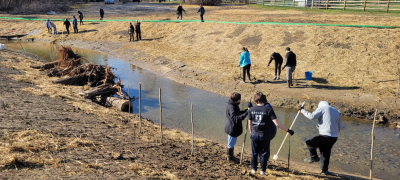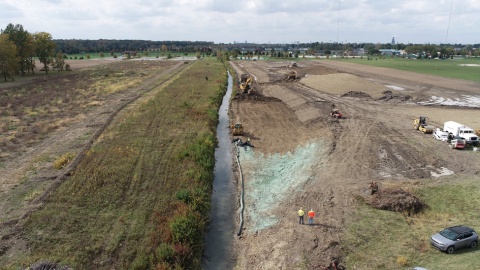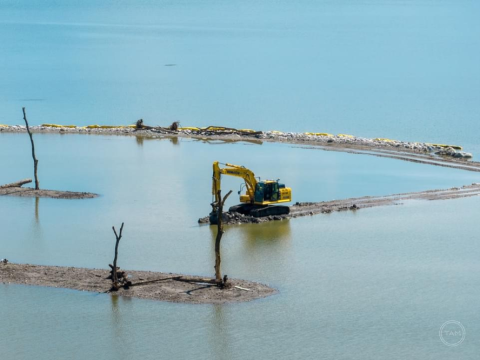Significant improvements are underway in the Maumee AOC as construction of 17 projects was recently completed, is underway, or is soon to-begin. Each project will address one or more Beneficial Use Impairments (BUIs) within the AOC. BUIs are designations identified in the 1987 amendment to the Great Lakes Water Quality Agreement that represent different types of environmental degradation (see Beneficial Use Impairments for the Great Lakes AOCs to learn more). Most of these projects will address the Degradation of Fish and Wildlife Populations, Degradation of Benthos (small aquatic organisms living in bottom sediment), and Loss of Fish and Wildlife Habitat BUIs.
Projects with Construction Complete(d) Summer 2024
- Hill Ditch Restoration at Toledo Natural Science Technology Center: This project restored the stream’s natural path and movement, stabilized 700 feet of eroding streambank, enhanced 650 feet of streamside habitat, and improved macroinvertebrate habitat. Additionally, the restored habitat is already providing students at the adjacent Toledo Natural Science Technology Center with an opportunity for hands-on engagement with concepts of stream ecology and restoration.
- Wetland Enhancement in the Riverine at Turtle Creek: This project restored local wetlands to allow for water infiltration into the soil and improve water quality. Additionally, the work enhanced the overall quality of aquatic habitat while maintaining existing protections against flooding upstream.
- Stream Restoration at the Oregon Recreational Complex: This project stabilized 5,300 linear feet of eroding and incised streambanks in Wolf Creek, creating important habitat features that allow fish to rest, hunt, and hide from predators. Additionally, the project will reduce non-point source pollution from agricultural runoff and excess sediment. The project’s location within the Oregon Recreational Complex has allowed the public to observe the process and results of stream restoration in real time.
- Maumee Bay State Park Waterfowl Deterrent: This project seeks to address closures and posted advisories for the park’s inland lake beach caused by high levels of bacteria from waterfowl (primarily geese) in the area. Selective plantings were used to disrupt the birds’ ability to scan the whole beach for predators, thereby discouraging their use of the area and reducing associated bacteria concentrations The plantings will also increase pollinator habitat and the area’s aesthetic value for beachgoers.
Projects Currently Under Construction
- Maumee State Forest Expansion: The project is being implemented at several sites that will expand the State Forest by approximately 150 acres. Some of these sites have converted farmland to either wetland or forest, restoring important wildlife habitat. This effort is the last remaining project being implemented to address the wildlife portion of Loss of Fish and Wildlife Habitat BUI in the AOC.
- Delaware Islands Complex Restoration: This project is designed to recreate valuable island habitat and protect areas that are currently at risk of erosion and loss due to increased water levels and flooding events. Shallow waters surrounding islands complexes are associated with high fish and benthic biodiversity.
- Packer Stream Restoration near Genoa State Route 163: The section of Packer Creek is continuously eroding and lacks valuable habitat features for fish and benthic communities. The project’s stream restoration work across several sites will improve habitat conditions along a total of 4,700 feet of streambank and create 18 acres of wetlands.
Projects with Construction Underway Soon
- Hill Ditch at Paisley Park: This project is designed to improve degraded benthic communities by widening the stream and creating more natural bends in its path. Additionally, the project will connect the ditch to a newly established wetland and improved riparian habitat. The location of this project provides a unique opportunity for stream restoration in a highly urbanized area.
- Audubon State Nature Preserve Islands Restoration: This project seeks to protect and enhance valuable island habitat in the mainstem of the Maumee River. The shallow waters around islands provide important habitat to both fish and benthic organisms. However, this island complex is at risk of erosion and loss due to higher water levels in Lake Erie and flooding.
- Channel Addition and Wetland Enhancement/Reconnection: This project aims to increase connectivity between Turtle Creek and nearby wetlands at two sites, as well as to enhance 17 acres of wetland habitat. Further, the project is expected to create 1,730 feet of habitat, contributing to the diversity of wetland types and nursery habitat for fish.
- Berlin Avenue Floodplain and Stream Improvements: This project will restore wetlands, increase instream and streambank cover, and capture storm water runoff, resulting in improved aquatic habitat along 2,200 feet of Otter Creek.
- Taylor Rd. and Yarrow St. Floodplain and Stream Improvements: The project is designed to restore vernal pool and streamside wetland habitat, improve instream cover, enhance 900 feet of riparian buffer, and capture stormwater runoff.
- Neis Ditch Stream Restoration: This project is designed to stabilize eroding streambanks and improve instream habitat, building on previous stream restoration work by Metroparks Toledo. Additionally, the work will enhance or create vegetated buffers along the stream and expand access to nearby floodplain. Residents will benefit from a reduction in flood risk and excess sediment/nutrient runoff, which will in turn improve Lake Erie’s water quality.
- Blue Creek Restoration at Blue Creek Metropark: This project is designed to stabilize 500 feet of eroding streambanks and improve instream habitat. The project will create important stream habitat features that support benthic organisms and allow fish to hunt, rest, and hide
- Maumee State Forest Blue Creek Stream Restoration at Hight Tract: This project is designed to improve degraded fish habitat in a conservation area owned by Ohio Department of Natural Resources (ODNR). The work will stabilize and prevent bank erosion, increase streamside and instream habitat, and divert runoff from nearby roads before it reaches the water.
- Stream Restoration at Lathrop Park: This project is designed to restore an eroded section of Tenmile Creek by creating and enhancing important in-stream and streamside habitat. In addition to providing habitat for fish, the work will also improve degraded benthic communities and improve the creek’s resilience to intense storms.
- Restoration of the Ottawa River within Jermain Park: This project aims to enhance habitat for fish and benthic organisms in one of the few undeveloped, forested areas adjacent to the lower sections of the Ottawa river. The work will stabilize 2,300 feet of eroding streambank and enhance 2.7 acres of wetland through diverse, native plantings.




